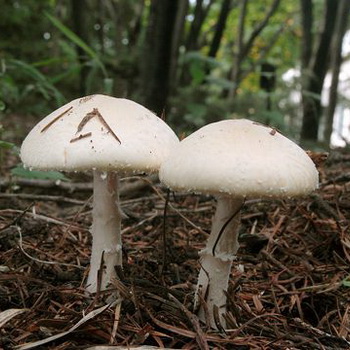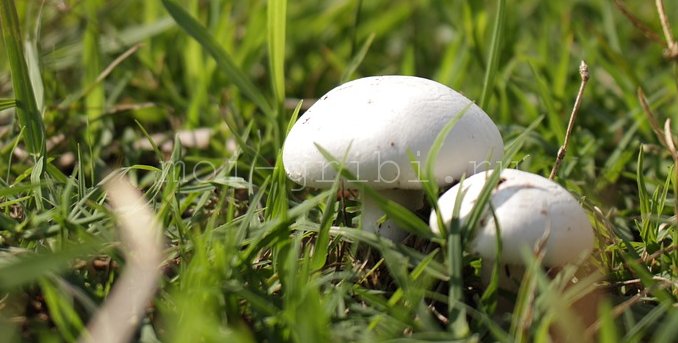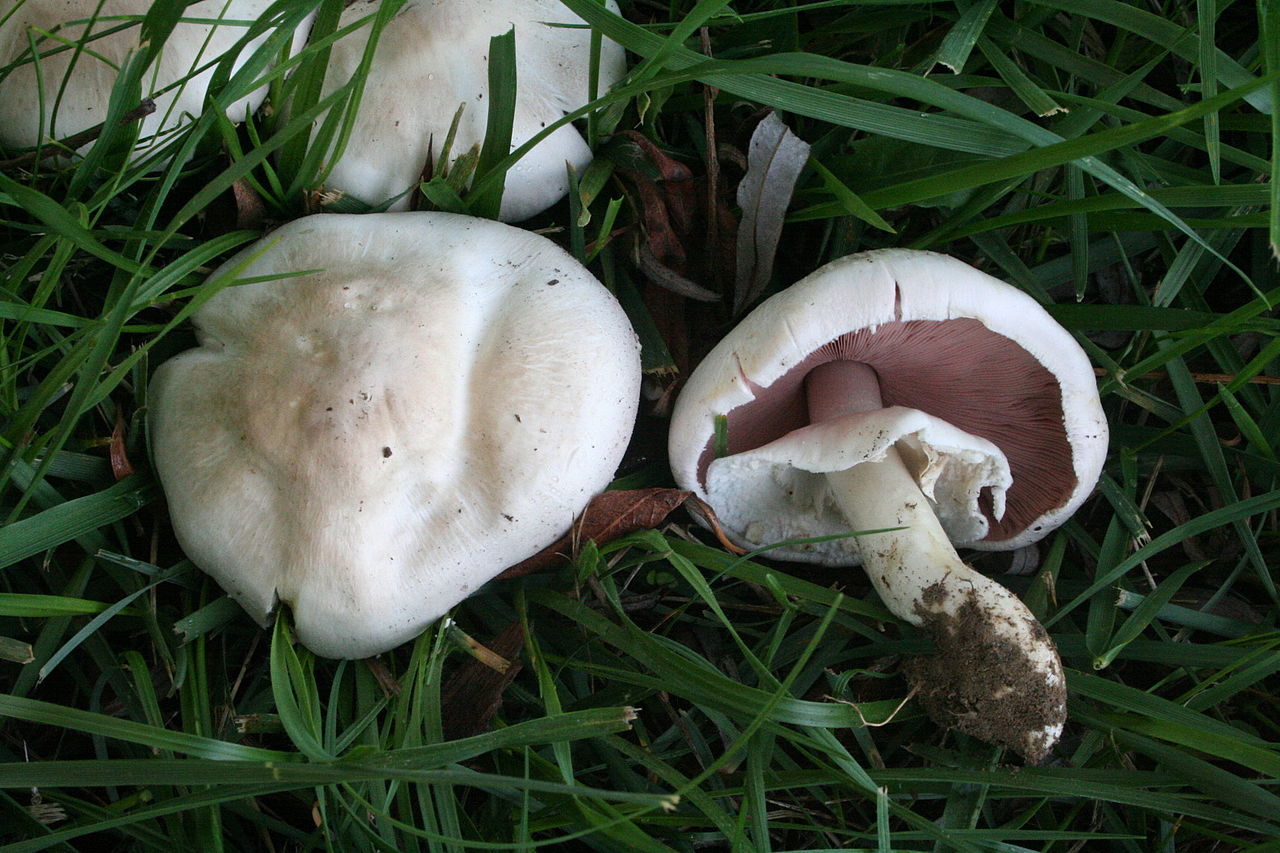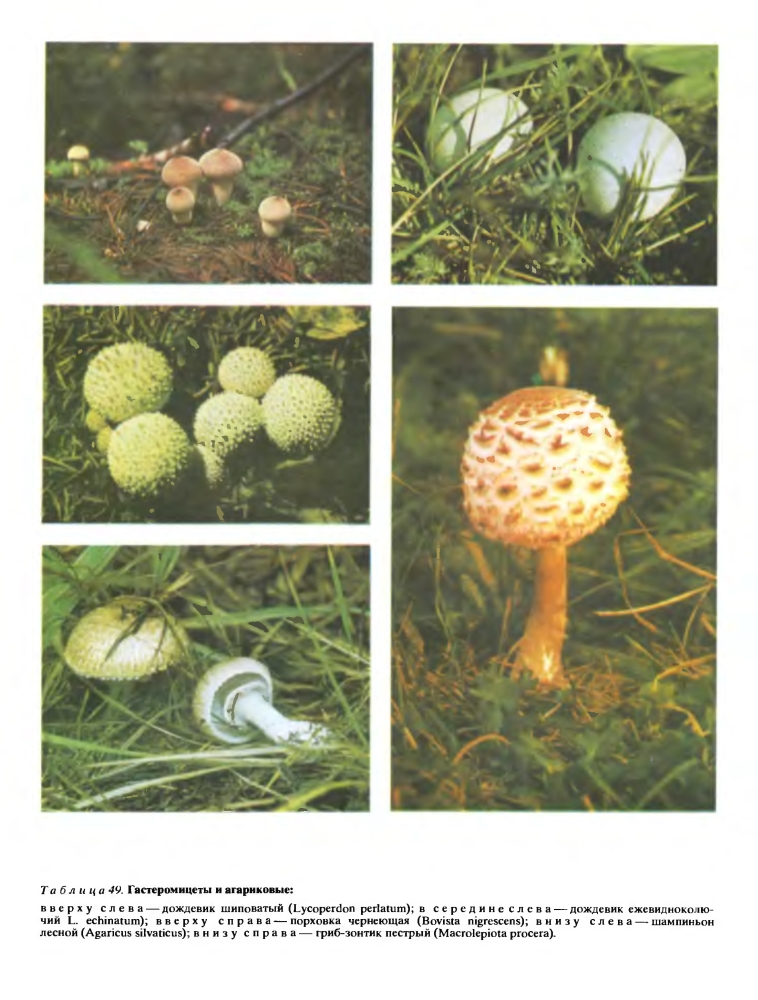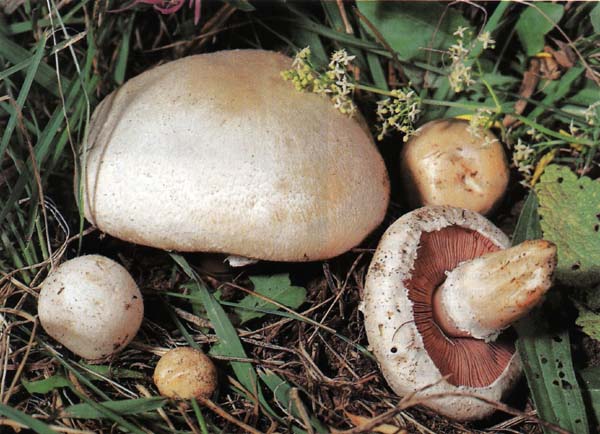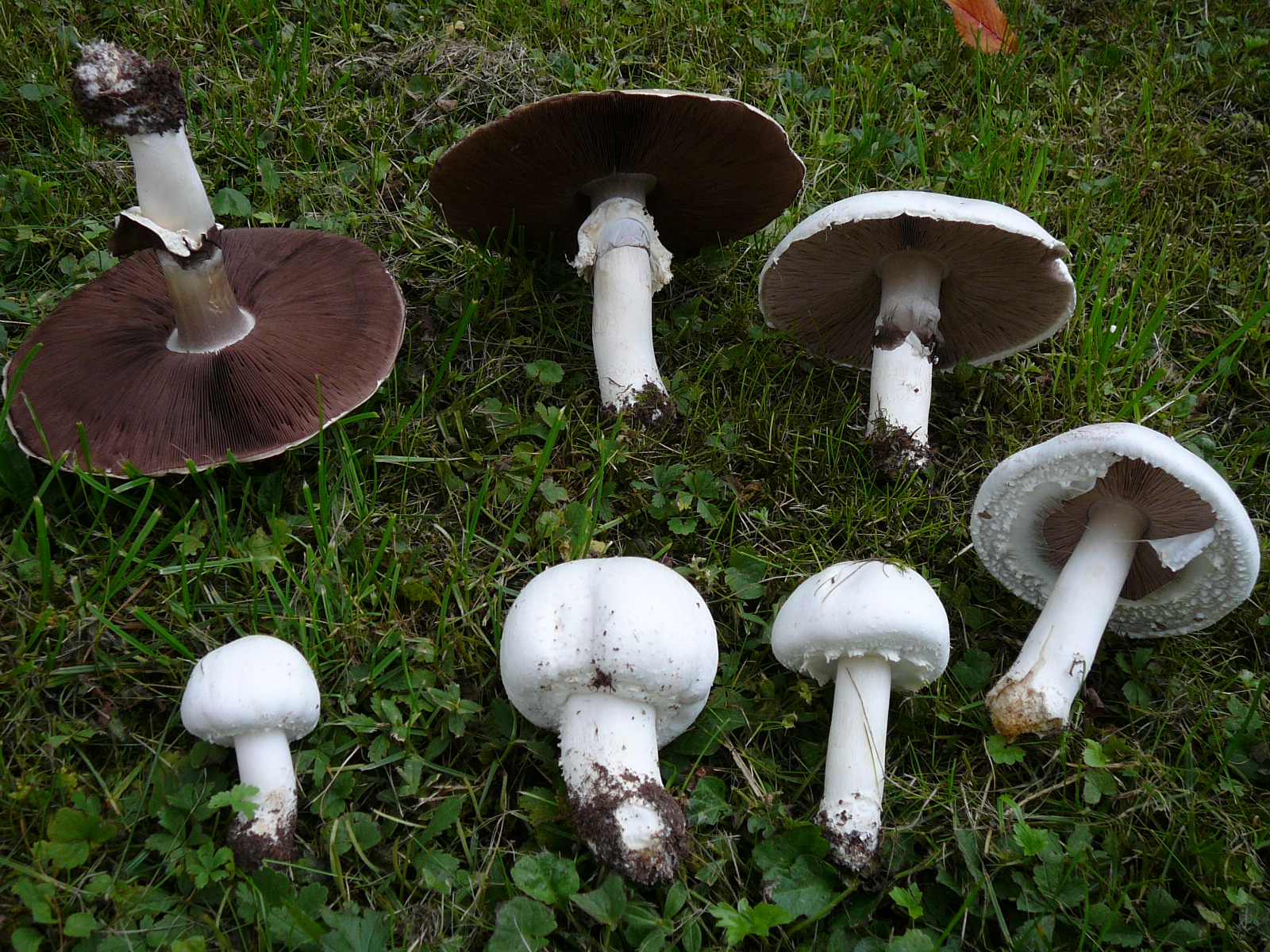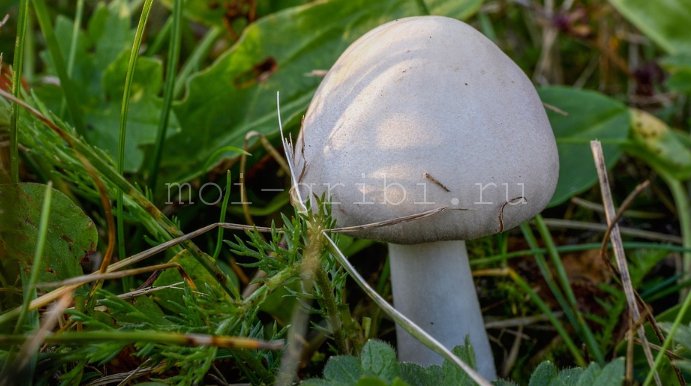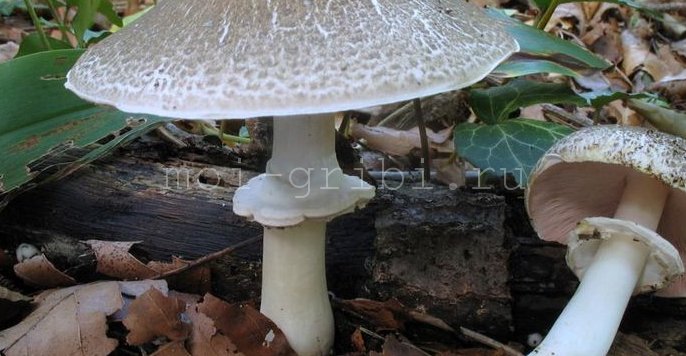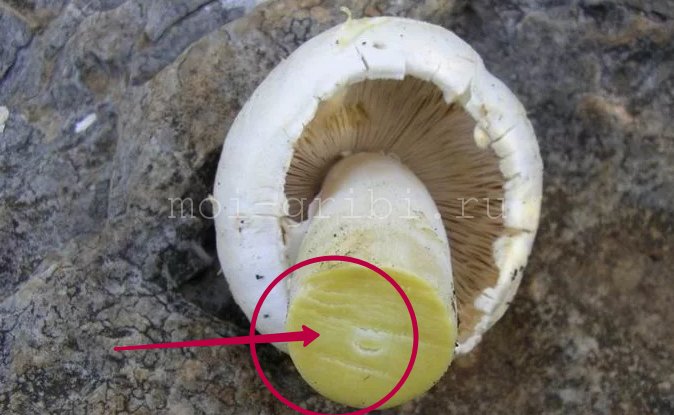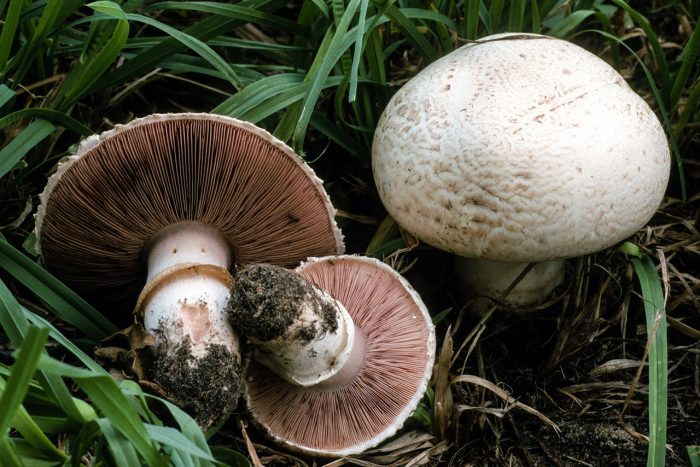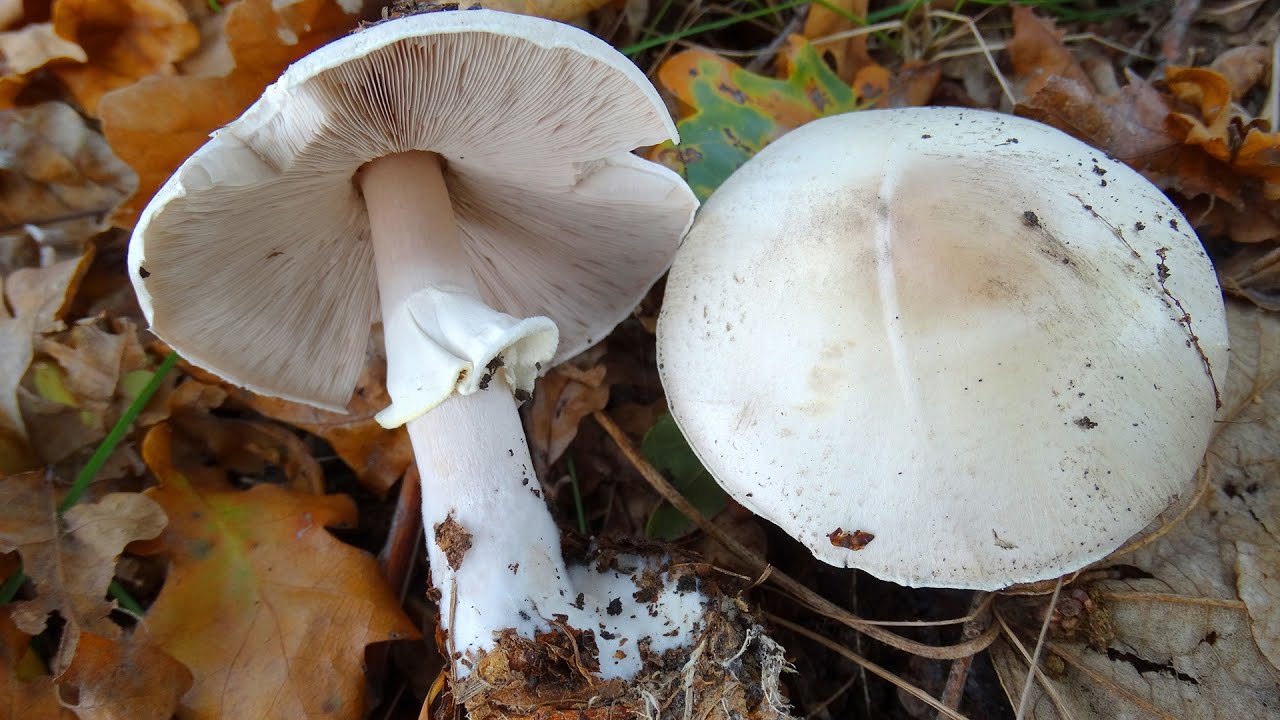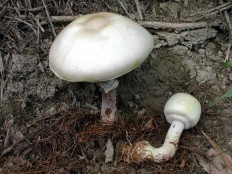Similar species
Due to its particularly large size, large-spore champignon is difficult to confuse with other species, but young specimens may look like some edible mushrooms:
The main difference is that this species is predominantly forest, and it grows mainly among the pines. It looks like it has a significant thickening of the base of the leg. By maturity, the hymenophore of fungi of this species acquires a black and red coloration, while in large spore it remains brown.
Most similar view. He is also large and prefers open spaces. Some sources even consider the large-spore champignon to be a species of field mushroom (Psalliota arvensis subsp. Macrospora), so there are no clear differences between them.
1-Champignon curve 2-Field champignon
Yellow-skinned champignon
In addition to harmless, edible species, there is also a poisonous double - this is Yellow-skinned or false champignon. It stands out with a distinct smell of gouache paint. Has a yellowish coloration of the base of the leg.
Also, young specimens may look like toadstools or fly agarics. Champignon can distinguish colored plates and slight reddening of the flesh when cut from the pale toadstool and the smelly fly agaric.
Thus, some doubles of the large-spore champignon can be very dangerous.
Therefore, you should pay attention to a number of their distinctive properties.
Evaluation of taste, medicinal properties, benefits and possible harm
The calorie content of fresh peppers is 27 kcal per 100 grams of product. Fresh mushrooms contain a whole list of vitamins B, E, PP and others. In addition, they also contain useful trace elements: calcium, potassium, manganese, zinc, copper, iron, phosphorus, about 20 essential amino acids. The high-quality protein found in mushrooms is an excellent alternative to meat protein, which the body uses to build cells.
Other useful properties of champignons:
- normalization of the activity of the cardiovascular system;
- lowering the level of "bad" blood cholesterol;
- removes salts of heavy metals;
- mushrooms contain antioxidant substances that fight free radicals.
- mushroom infusion is used to treat wounds;
- in the treatment of diabetes mellitus to lower blood sugar levels;
- folk healers used oven extract to fight typhoid fever.
Doctors warn that it is forbidden to eat any mushrooms for children under 12 years old, pregnant and lactating women, people with exacerbations of chronic diseases of the gastrointestinal tract. Do not forget that mushrooms contain chitin (especially a lot of it in the legs), which is very difficult to digest. Mushrooms are a sponge, they quickly absorb salts of heavy metals, pesticides and nitrates, harmful substances. You should not pick mushrooms near major roads, factories and factories. This is not necessary, because today in stores there is a huge selection of safe bakers grown in an industrial environment.
Yellow-skinned champignon (Agaricus xanthodermus)
- Other names for the mushroom:
- Red champignon
- Yellow-skinned peasant
Synonyms:
Description: Yellow-skinned champignon is also called yellow-skinned peppermint. The fungus is very poisonous, poisoning with it leads to vomiting and numerous disorders in the body. The danger of the peppers lies in the fact that in their appearance it is very similar to many edible mushrooms, which, for example, are edible champignons.
The yellow-skinned peasant is decorated with a yellow-skinned white cap with a brownish blotch in the center. When pressed, the cap becomes yellowish. Mature mushrooms have a bell-shaped cap, while young mushrooms have a rather large and rounded cap, reaching fifteen centimeters in diameter.
The plates are at first white or pinkish; with age, the fungus turns gray-brown.
The leg is 6-15 cm long and up to 1-2 cm in diameter, white, hollow, tuberous-thickened at the base with a wide white, thickened along the edge of the two-layer ring.
The brownish-colored flesh at the base of the leg turns yellow quite strongly. During heat treatment, the pulp emits an unpleasant, intensifying phenolic odor.
The emerging spore powder is dark brown in color.
Spreading:
Yellow-skinned champignon bears fruit actively in summer and autumn. It appears especially in abundant quantities after rains. It is found not only in mixed forests, but also in parks, in gardens, in all areas overgrown with grass. This type of mushroom is widespread throughout the world.
Habitat: from July to early October in deciduous forests, parks, gardens, meadows.
Grade:
The fungus is poisonous and causes stomach upset.
The chemical composition of this mushroom is currently not established, but, despite this, the mushroom is used in folk medicine.
Video about the yellow-skinned champignon mushroom:
Note: The distinguishing features of the yellow-skinned champignon from the edible mushroom are its yellowing places when touched and an unpleasant phenolic odor emitted.
Professional mushroom pickers easily distinguish yellow-skinned champignon from edible types of mushrooms, knowing its signs. But inexperienced amateurs mushroom pickers need to recognize and distinguish the distinguishing features of this poisonous mushroom. A mushroom mistakenly eaten will cause poisoning, albeit mild, but quite unpleasant for a person.
The name comes from "xanthos" (Greek) - yellow and "derma" (Greek) - leather.
Description
The cap of the mushroom is 2-5 cm in diameter, thin-fleshy, initially semi-circular or bell-shaped, opens to a convex-outstretched or wide-spread, in the center there may be a small tubercle. The edge is thin, at first tucked up, later wavy, with the remains of a veil. The surface is whitish or yellowish, in the center with a pink tint, to violet-pink or brownish, glabrous or with fibrous adpressed small scales in the center.
thin, loose, frequent, at first pink, dirty pink, when ripe they become meat-red, then dark brown or purple-brown. When exposed to α-naphthol, a red color appears. The trama of young plates is correct, then it becomes incorrect.
The leg is about 3-5 cm high and up to 0.5 cm thick, cylindrical, central, flat or sometimes widened at the base, solid or fistular. The surface is silky-fibrous, white, with a yellow tint at the base.
The flesh is white, yellowish under the skin of the cap, at the base of the stem turns yellow on the cut, with a pungent taste and almond odor. Gives a positive Schaeffer reaction, under the action of nitric acid, the pulp, as well as the surface of the cap and legs, turn slightly yellow.
Remains of bedspreads: there is a ring on the upper part of the leg, narrow, soft, whitish, at first it lags behind the leg, later hangs down, and may disappear over time.
The spore powder is brown, the spores are smooth, broadly ellipsoid or ovoid, 4–5.5 × 3–3.5 µm, with a lateral apiculus, contain a fluorescent drop.
Basidia are clavate, tetrasporous, 15-17 × 4-5 µm, with sterigmas 2-2.5 µm long. Gymnial cystids are absent.
Edible doubles
Champignon species are widespread throughout the globe, and in this genus, most good edible mushrooms, not just poisonous species.
Common champignon (Agaricus campestris) is a European species characterized by a white cap, a stockier body, unpainted surfaces and flesh, pink or brown gills, a grass habitat, and microscopic signs of 6.5–8.5 µm spores. Grows singly, in groups or in arcs and rings of fairies, in meadows, fields, lawns and grassy areas. Provided they are properly cooked and eaten in moderation (not as a daily meal!) Field mushrooms are healthy and delicious.It is unwise to collect food from the grassy slopes of busy roads, because the soil, vegetation and mushroom fruiting bodies from such places can be contaminated with toxins released from exhaust gases or from oil spills.
Field or horse champignon (Agaricus arvensis) is also an edible species that can easily be mistaken for yellow-skinned champignon. The specific epithet arvensis means "fields" or "meadows" - where the horse mushroom is most often found. The cap of Agaricus arvensis matures from 8 to 20 cm (rarely up to more than 30 cm). The surface is white, but yellowing with age, smooth or finely scaly, the cap is initially spherical and expands until it is flat or nearly flat. The flesh is thick and white and firm. The gills are pale pink at first, darkening, and then brown. The stem is up to 10 cm tall, the parallel stem is usually a small bulb at the base and a sturdy double ring with a toothed wheel on the underside.
When cut, the base of the stem of Agaricus arvensis does not turn bright yellow for a long time. This is a helpful visual distinction between this edible mushroom and the poisonous yellow-skinned champignon, Agaricus xanthodermus. This toxic toadstool changes color as soon as the edge of the cap is damaged.
Double-ringed champignon (Agaricus bitorquis) is an edible porcini mushroom of the genus Agaricus, which is similar to the poisonous yellow-skinned champignon. It gets its generic name from the habit of growing on sidewalks, surprisingly it can even grow through asphalt. Usually grows in groups of the same size, they are quite sturdy and relatively easy to identify. They do not turn yellow when cuts or abrasions appear, which eliminates the presence of a toxic yellow dye like Agaricus xanthodermus. The specific epithet bitorquis means "to have two collars," and refers to the two rings resulting from the separation of the annular space from both the top and the bottom of the leg.
Poisonous types of champignons
Among wild mushroom species, poisonous varieties are quite common, the consumption of which can have serious negative consequences for health.
That is why it is very important to know what a poisonous specimen looks like and what characteristic distinctive features it has.
In addition to the poisonous representatives of the champignon family, there are a number of mushrooms that, in appearance, very much resemble the described fruiting bodies, but are not their "relatives", the so-called doubles or false ones. Most of all, inedible specimens are similar to the pale toadstool or white fly agaric.
Important! Heat treatment of poisonous fruit bodies does not deprive them of toxicity.
You can recognize a poisonous mushroom by some signs:
- The color of the pulp at the cut. In inedible representatives, the color of the pulp after breaking or cutting it remains the same, does not oxidize, unlike high-quality champignons.
- The color of the plates. An adult edible champignon changes color to a darker color of the plates, which are located on the inside of the cap. In poisonous fruit bodies, the color of the plates does not change during the entire period of ripening.
- Root pouch. One of the most important differences between toxic mushrooms is the presence of a sac, that is, a small swelling at the root. The bridesmaids do not have it.
- Aroma. Edible champignons give off a pleasant mushroom, almond or anise aroma, in contrast to the poisonous ones, which often smell like medicines.
Champignons are not only one of the most common and accessible types of mushrooms, but also one of the most useful. They contain a large amount of protein, so they can become a full-fledged substitute for meat. However, going out on a "quiet hunt" you need to remember that there are inedible varieties and poisonous counterparts, the use of which can lead to detrimental consequences for human health.
It looks like a field fellow, only the leg is yellowish-orange. The damaged skin or pulp also acquires a yellow tint, exudes a nasty smell, reminiscent of carbolic acid.
He's ginger
It has a medium-sized head, widening at the edges, the surface is covered with small scales. If you press on the pulp with your fingernail, it instantly turns yellow. The stem is thin, often empty inside, bordered by a small fibrous rim. On the inner side of the cap there are thin, frequent plates of light shades (can be beige or pink); during aging, the plates darken and become brown-brown.
Other names are carbolic, flat, scaly. By the appearance of the fruit, it is easy to determine which mushroom is in front of you - a gray cap with a darkened core also exudes the smell of carbolic acid. Folk healers and experienced old women argue that this variety is suitable for eating if the deceptive forest gift is thermally processed at least five times, but it is better not to risk your own health.
We have considered the most common types of champignons, since they are most often found by numerous gatherers. Do not be afraid to go for the forest harvest, improve your knowledge and remember the golden rule of any forester - “Doubt? Do not take".
Description of the elegant champignon
Champignon graceful - a beautiful fungus that resembles a miniature copy of an ordinary champignon. The diameter of its cap is only 2.5-3.5 centimeters. The shape of the cap is hemispherical, while the spore-bearing layer is covered with a blanket.

Over time, the cap transforms into a spread one, and the bedspread breaks, as a result of which its remains hang on the edges of the cap. The surface of the cap is matte, dry, gray-yellow in color with a pink tint.
The length of the leg reaches 3 centimeters, and its thickness does not exceed 4-5 millimeters. The shape of the leg is rounded, at the base it is thinner. The surface of the leg is smooth. Its color is yellowish. There is a sagging narrow ring on the leg immediately under the cap. Mature specimens have no rings. The pulp is thin. The smell of the pulp is aniseed, barely perceptible.
Places of growth of graceful champignons
It is a rare mushroom that grows singly or in groups. Delicate mushrooms bear fruit from July to September. They grow in mixed and deciduous forests, in addition, they can be found on fertile soils in vegetable gardens, orchards, lawns, parks and lawns. Graceful champignons always grow among the grass. They bear fruit from June to October.

Taste qualities of pink-lamellar champignons
Delicate champignons are edible and delicious mushrooms. They have a pungent aniseed taste and smell. They are suitable for all types of culinary processing. They can be boiled, fried, pickled and harvested for future use.
Other mushrooms of this genus
Long-rooted white champignon is an edible mushroom. His hat is characteristically outstretched. Its diameter is 4-13 cm. The edges of the caps of young mushrooms are tucked up, but over time they straighten out. The surface of the cap is fleecy or scaly. The color of the cap is gray-brown or whitish, with a darker center. The pulp is white, dense with a strong walnut smell. The leg length ranges from 4 to 12 centimeters and the width is 1.5-2.5 centimeters. Its shape is fusiform, the base is narrowed. In color, it is the same color as the hat. If you touch the leg, it turns brown. There is a white ring on the leg.
Long-rooted white champignons grow in Eurasia, North America and Australia. Also found in our country - in Rostov-on-Don.

These are quite rare mushrooms, which are mainly found in gardens, arable lands, parks, along roadsides. They can settle in small groups or singly.
The flat mushroom champignon is an inedible member of the family. The diameter of its cap is 5-9 centimeters. As it grows, its shape changes from ovoid to flat with a small tubercle in the center. The skin is white, dry, with a large number of small gray-brown scales. The stem is fibrous, has a slight tuberous thickening, its height reaches 9 centimeters, and its diameter is about 1 centimeter. There is a rather large ring on the leg.
Mushrooms grow flat-cap mushrooms in the fall.They can be seen in deciduous and mixed forests, sometimes found near dwellings. Witch rings are often formed.

Cossack champignon (Agaricus sylvicola)
Synonyms:
Coppice champignon (Latin Agaricus sylvicola) is a mushroom of the mushroom family (Agaricaceae).
Hat:
Color from white to cream, 5-10 cm in diameter, first spherical, then prostrate-convex. Scales are practically absent. The pulp is relatively thin, firm; anise smell, nutty taste. When pressed, the cap readily takes on a yellow-orange color.
Plates:
Frequent, thin, free, when the mushroom ripens, it gradually changes color from light pink to dark brown.
Spore powder:
Dark brown.
Leg:
5-10 cm high, thin, hollow, cylindrical, slightly widening at the base. The ring is strongly pronounced, white, can hang low, almost to the ground.
Spreading:
Coppice champignon grows singly and in groups in deciduous and coniferous forests from June to late September.
Similar species:
It would be a big mistake to mistake the pale toadstool (Amanita phalloides) for the champignon. This, one might say, is a classic of toxicology. Nevertheless, the main differences between champignons and representatives of the genus Amanita should be known to every young mushroom picker. In particular, the plates of the pale toadstool never change color, remain white until the end, while in champignons they gradually darken, from light cream at the beginning to almost black at the end of their life path. So if you find a small lonely champignon with white plates, leave it alone. This is a poisoned pale toadstool.
It is much easier to confuse Agaricus sylvicola with other members of the mushroom family. Agaricus arvensis is usually larger and does not grow in the forest, but grows in the fields, in gardens, in the grass. Poisonous Agaricus xanthodermus has a strong unpleasant odor (which is described differently everywhere - from carbolic acid to ink), and does not grow in the forest, but in the field. You can also confuse this species with the crooked champignon or, otherwise, "distinctly nodule" (Agaricus abruptibulbus), but the latter is somewhat thinner, higher, does not turn yellow so readily, and is less common.
Edibility:
Cossack Champignon - This is a good edible mushroom that rivals the best of champignons.
Video about mushroom champignon coppice
Remarks Still, it remains unclear how to distinguish between numerous similar types of champignons, even if professionals cannot agree on this. On the one hand, the mind prompts you to focus on the habitat. On the other hand, this is fully justified only for mycorrhizal fungi, and champignons, like all saprotrophs, in principle can grow everywhere, if there would be fertilization.






